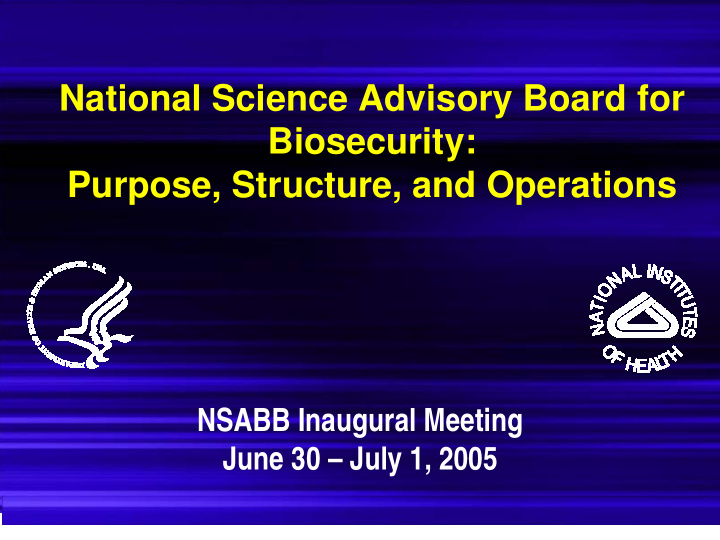



National Science Advisory Board for Biosecurity: Purpose, Structure, and Operations NSABB Inaugural Meeting June 30 – July 1, 2005
Life Sciences Research: National Biosecurity Initiatives • U.S. government has enhanced biosecurity in life sciences research through several initiatives: – USA PATRIOT Act of 2001 – Public Health Security and Bioterrorism Preparedness and Response Act of 2002 – Agricultural Bioterrorism Protection Act of 2002 – Promoting and conducting research on the development of countermeasures for biologic threats
Report of the National Research Council of the National Academies • “Biotechnology Research in an Age of Terrorism” (October 2003) • Description of “Experiments of Concern” • Recommendations included: – Creation of a national advisory board – Education of science community – System to review plans for certain research – Self-governance in review for publication – Increase in communication between life scientists, security, and law enforcement
NSABB Purpose and Function • To advise HHS Secretary, NIH Director, and heads of all Federal entities that conduct/support life sciences research. • To recommend strategies for the effective oversight of federally conducted or supported dual use research – Dual use research is research with legitimate scientific purpose that may be misused to pose threat to public health or national security – The NSABB will consider both the needs of the research community and concerns about national security
NSABB Charge Develop criteria for identifying dual use • research and research results Develop guidelines for oversight of dual • use research, including guidelines for risk/benefit analyses Advise on national policies governing • local review and approval for dual use research, including guidelines for case- by-case review and approval by Institutional Biosafety Committees (IBCs)
NSABB Charge (cont’d) • Advise on criteria and processes for referral of classes of research or specific experiments by IBCs to the NSABB – Review/provide guidance on specific experiments that exemplify significant or complex permutation, or represent a new category of dual use research – Respond to research institutions’ requests for interpretation and application of guidelines to specific proposals that have been denied by an IBC
NSABB Charge (cont’d) Provide recommendations regarding the development • of a code of conduct for scientists and laboratory workers for adoption by professional societies and institutions engaged in life sciences research Provide recommendations on the development of • mandatory programs for education and training in biosecurity for all scientists and laboratory workers at federally-funded institutions Advise on national policies for publication, • communication and dissemination of dual use research methodologies and results
NSABB Charge (cont’d) • Provide recommendations regarding strategies for coordinated international oversight of dual use biological research • Advise on national policies for conduct of dual use research including strategies to address national security concerns while still fostering continued rapid progress in life sciences research • Address other issues as directed by the Secretary of HHS
NSABB Structure / Operations • Up to 25 voting members appointed by Secretary, HHS, after consultation with other Federal Agencies • Meets quarterly and as needed • Meetings open to public, unless otherwise determined by the Secretary, HHS • Managed and administered by the NIH
NSABB Expertise Bioethics Molecular • • biology/genomics National security • Microbiology • Intelligence • Clinical infectious • Biodefense • disease/diagnostics Institutional Biosafety • Lab biosafety/security • Committees Public health, • Export controls • epidemiology Law, law enforcement Health physics • • Scientific publishing Pharmaceutical • • production Perspectives from • Veterinary medicine academia, industry, • Plant health public, recombinant DNA • Advisory Committee Food production •
NSABB ex officios United States Department of • Exec. Office of the President • Agriculture Department of Health and • Department of Interior • Human Services National Science Foundation Department of Energy • • Department of Justice • Department of Homeland • Department of State Security • Department of Commerce Department of Veterans Affairs • • National Aeronautics and Department of Defense • • Space Administration Environmental Protection • Intelligence community Agency •
Modus Operandi • Engage the biosafety, security, life sciences research, and public communities in NSABB activities such as the development of the guidelines, code of conduct, and training programs • Recognize and develop strategies to address the significant challenges that will face: – Researchers – IBCs – Institution leadership and research administrators – Publishers
Role of the NIH Office of Biotechnology Activities • NIH manages the NSABB on behalf of DHHS – Plan and execute meetings – Develop background materials and support/oversee development of NSABB work products • Maintains website as resource for public • Identifies and analyzes dual use research issues • Facilitates coordination of the development of federal policies regarding dual use research • Participates in the implementation and interpretation of federal guidelines for dual use research • Develops training and education programs for IBCs involved in dual use research
NSABB Website http://www.biosecurityboard.gov email: nsabb@od.nih.gov
Office of Science Policy Office of the Director, NIH 6705 Rockledge Drive, Suite 750 Bethesda, Maryland 20892-7985 Phone (301) 496-9838 Fax (301) 496-983
Recommend
More recommend